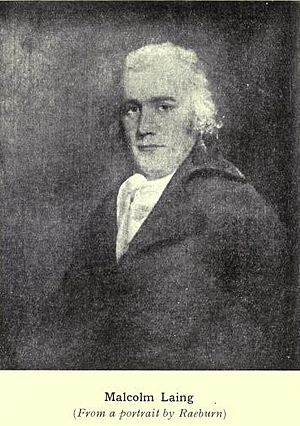Malcolm Laing facts for kids
Malcolm Laing (born 1762 – died 1818) was a Scottish historian, lawyer, and politician. He was known for his writings about Scottish history and for his strong opinions on famous literary works.
Contents
Life of Malcolm Laing
Malcolm Laing was born in 1762 on an estate called Strynzia, located on the island of Stronsay in Orkney, Scotland. His parents were Robert Laing and Barbara Blaw. He had two brothers, Samuel Laing and Gilbert Laing Meason. Malcolm went to the grammar school in Kirkwall and later studied at Edinburgh University. He joined a discussion group called the Speculative Society in 1782.
In 1785, Laing became a lawyer, also known as an advocate. For five years starting in 1789, he worked as a lawyer helping people who could not afford legal help. Around 1790, he was involved in politics in Orkney, supporting the Whig political party. In 1794, he helped defend Joseph Gerrald in a case where Gerrald was accused of stirring up rebellion. A friend, Sir James Mackintosh, thought Laing spoke too fast, which might have held back his legal career. However, another person, Henry Cockburn, Lord Cockburn, liked his strong, direct Scottish way of speaking.
Laing signed a statement for the Society of Friends of the People in 1794 and joined the Whig Club. He was a personal friend of the famous politician Charles James Fox. Laing was part of a group of advisors who helped Fox with his work on British history in the early 1800s. From 1807 to 1812, Laing was a Member of Parliament for Orkney and Shetland. He was brought into Parliament by a government known as the Ministry of All the Talents.
In 1808, Laing became unwell and stopped working in public life. He brought merino sheep to the islands of Eday and Sanday. He bought these sheep from a flock that once belonged to Sir James Montgomery, 1st Baronet. Towards the end of his life, he also tried to bring brown hares to the islands.
Malcolm Laing's Writings
Historical Works
Malcolm Laing helped finish a book called History of Great Britain by Robert Henry, adding the final volume in 1793. He also wrote his own book, History of Scotland from the Union of the Crowns to the Union of the Kingdoms (published in 1800). In a second edition of his History in 1804, half of the book was about Mary, Queen of Scots. This part, called Dissertation on the participation of Mary Queen of Scots in the Murder of Darnley, was very critical of Mary and discussed the Casket Letters. Like other historians, Laing focused on some of the negative parts of early Scottish history. In 1804, Laing also edited a book called The Historie and Life of King James the Sext.
Laing believed in a theory about the Picts, an ancient group who helped form the Kingdom of Scotland. He thought they were not Celts but had a Germanic origin. He agreed with the ideas of John Pinkerton on this topic, as did John Jamieson and James Sibbald.
Critic of Ossian Poems
In 1805, Laing published a two-volume work called Poems of Ossian, containing the Poetical Works of James MacPherson in Prose and Verse, with Notes and Illustrations. This book included early writings by James Macpherson, who had created the famous Ossian poems. Macpherson had died in 1796. Laing's book also showed how Macpherson might have used ideas from modern sources. Laing's criticism was very important for the idea that Macpherson had used a study of Hebrew verse by Robert Lowth to create his own supposed translations.
The "Ossian debate" was a big discussion about whether the Ossian poems were truly ancient or if they were made up. Laing had a confession from Macpherson that he had completely made up the poems. This confession had been shared with another person, Sir John Elliott, who then told Thomas Percy. However, a report from the Highland Society in 1805 said the poems were real. Percy suggested that everyone should stop blaming each other.
Family Life
On September 10, 1805, Malcolm Laing married Margaret Dempster Carnegy. She was the daughter of Thomas Carnegy of Craigo and Mary Gardyne. Margaret's sister was married to Adam Gillies, Lord Gillies, who was also a lawyer.


